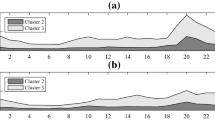Abstract
The growth of any country depends upon the availability, accessibility and growth of electricity. The need of energy rises due to the modern lifestyle and advanced technologies in residential sector and hence in industrial sector. The un-even demand in energy during different time intervals of a day leads to unbalanced load curve at power plant. To balance the load curve, demand during peak hours need to be reduced and this can be adjusted during off peak hours. Therefore, this paper presents the load scheduling scheme for residential consumers with the combinations of existing tariff structure. This will help in reducing the peak load thereby benefitting both consumers and utility. The case study of residential consumer with the combinations of tariff structures like (1) slab-wise tariff, (2) slab-wise tariff and Time of day tariff (ToD) with usual load pattern and (3) slab-wise tariff & ToD tariff with load scheduling is presented to validate the proposed load scheduling scheme. The same proposal with little modifications can be implemented for industrial sector also.
Access this chapter
Tax calculation will be finalised at checkout
Purchases are for personal use only
Similar content being viewed by others
References
Demand side management in india: an overview of state level initiatives. Prayas Energy group. http://www.prayaspune.org/peg/publications/item/281-demand-side-management-in-india-an-overview-of-state-level-initiatives.html
Talhar AS, Bodkhe SB (2019) The global survey of electrical energy distribution system: a review. IJECE 19:2247–2255. https://doi.org/10.11591/ijece.v9i4
Central Electricity Authority Report (Government of India) (2017) http://www.cea.nic.in/annualreports.html
Hu Q, Li F (2013) Hardware design of smart home energy management system with dynamic price response. IEEE Trans Smart Grid 4(4):1878–1887
Chen X, Wei T (2013) Uncertainty-aware household appliance scheduling considering dynamic electricity pricing in smart home. IEEE Trans Smart Grid 4(2):932–941
Guo Y, Pan M, Fang Y (2012) Optimal power management of residential customers in the smart grid. IEEE Trans Parallel Distrib Syst 23(9):1593–1606
Rajan S, Thomas M (2015) An efficient home energy management algorithm for demand response analysis in Indian scenario. In: IEEE Annual India Conference (INDICON) 2015
Mathavi S, Vanitha D, Jeynanthi S, Kumaran PS (2012) The smart home: renewable energy management system for smart grid based on ISM band communications. Int J Sci Eng Res 3(3):1–8
Al-Ali AR, Hag AE, Bahadiri M, Harbaji M, Haj YA (2011) Smart home renewable energy management system. Energy Procedia 12:120–126 Elsevier
Solanki PS, Mallela VS, Zhou C (2013) An investigation of standby energy losses in residential sector: solutions and policies. Int J Energy Environ 4(1):117–126
Moghe R, Lambert FC, Divan D (2012) Smart stick-on sensors for the smart grid. IEEE Trans Smart Grid 3(1):241–252
Mishra A, Irwin D, Shenoy P, Kurose J, Zhu T (2013) Green charge: managing renewable energy in smart buildings. IEEE J Sel Areas Commun 31(7):1281–1293
Byun J, Hong I, Kang B, Park S (2011) A smart energy distribution and management system for renewable energy distribution and context-aware services based on user patterns and load forecasting. IEEE Trans Consum Electron 57(2):436–444
Ferreira HL, Garde R, Fulli G, Kling W, Lopes JP (2013) Characterization of electrical energy storage technologies. Elsevier J Energy 53:288–298
Bedi HS, Singh N, Singh N (2016) A technical review on solar-net metering. In: India international conference on power electronics (IICPE)
Maharaja K, Balaji PP, Sangeetha S, Elakkiya M (2016) Development of bidirectional net meter in grid connected solar PV system for domestic consumers. In: International conference on energy efficient technologies for sustainability (ICEETS)
Nazar N, Abdullah M, Hassan M, Hussin F (2012) Time-based electricity pricing for demand response implementation in monopolized electricity market. In: IEEE students conference on research and development (Malaysia)
Azman N, Abdulla M, Hassan M, Said D, Hussain F (2017) Enhanced time of use electricity pricing for industrial customers in Malaysia. Indonesian J Electr Eng Comput Sci 6(1):155–160
Shaikh S, Dharme A (2009) Time of use pricing-India, a case study. In: Third international conference on power systems, Kharagpur, INDIA
Maharashtra State Load Dispatch Center, mahasldc.co.in
Author information
Authors and Affiliations
Corresponding author
Editor information
Editors and Affiliations
Rights and permissions
Copyright information
© 2021 Springer Nature Singapore Pte Ltd.
About this paper
Cite this paper
Talhar, A., Bodkhe, S. (2021). Load Scheduling with Combinations of Existing Tariff Structure for Residential Consumers in Maharashtra, India—Case Study. In: Gunjan, V.K., Zurada, J.M. (eds) Proceedings of International Conference on Recent Trends in Machine Learning, IoT, Smart Cities and Applications. Advances in Intelligent Systems and Computing, vol 1245. Springer, Singapore. https://doi.org/10.1007/978-981-15-7234-0_5
Download citation
DOI: https://doi.org/10.1007/978-981-15-7234-0_5
Published:
Publisher Name: Springer, Singapore
Print ISBN: 978-981-15-7233-3
Online ISBN: 978-981-15-7234-0
eBook Packages: Intelligent Technologies and RoboticsIntelligent Technologies and Robotics (R0)




